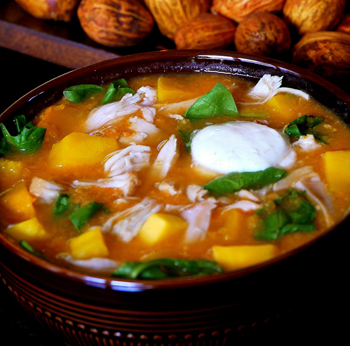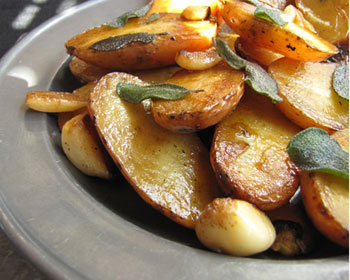 If you listen to conventional wisdom, you might think roasting is the only way to go when it comes to cooking fingerling potatoes. Now, I am usually the poster-girl for roasting (potatoes or anything else), and I’d like not to be burned at the stake for potato heresy, but I think fingerling potatoes are usually better braised or simmered, or, yes, boiled—any method that involves a little liquid.
If you listen to conventional wisdom, you might think roasting is the only way to go when it comes to cooking fingerling potatoes. Now, I am usually the poster-girl for roasting (potatoes or anything else), and I’d like not to be burned at the stake for potato heresy, but I think fingerling potatoes are usually better braised or simmered, or, yes, boiled—any method that involves a little liquid.
I hate to generalize, because there are, in fact, many different varieties of fingerling potatoes. Fingerlings themselves aren’t a variety, but more of a type of potato, defined by their size and shape—small, knobby, and elongated. Their flavor is usually rich and concentrated, but the color of their skin and flesh, as well as their starch content, can vary quite a bit from variety to variety. (Popular varieties include Russian Banana, Purple Peruvian, Ruby Crescent, and French Fingerling.)
The varying starch level is why some fingerlings lean towards being fluffy and dry (like a Russet potato), while others have creamy or waxy flesh (like a Red Bliss potato). Unless you cook with the same variety a lot, it’s hard to always know exactly what you’re getting at the store (or the farmers’ market) or how it will behave in the dry heat of the oven. While I’ve had bad experiences with Russian Bananas over-drying when roasted, I’ve never had a fingerling that wasn’t perfectly delicious when cooked with a wet-heat method.

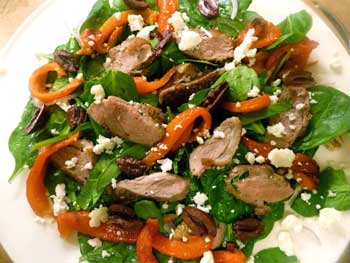 If you don’t think salad is a hearty enough meal for the dead of winter, this one will certainly change your mind… With a warm duck breast sliced atop a flavor packed mix of greens, vegetables, nuts and cheese, it’s a dish that’s rich and satisfying but also pretty skinny.
If you don’t think salad is a hearty enough meal for the dead of winter, this one will certainly change your mind… With a warm duck breast sliced atop a flavor packed mix of greens, vegetables, nuts and cheese, it’s a dish that’s rich and satisfying but also pretty skinny.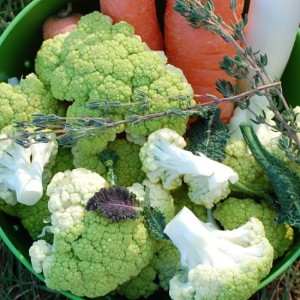 If it’s January, I must be cooking
If it’s January, I must be cooking  I always crave banana bread -- moist, tender, nut studded slabs with plenty of butter on top. I don't always crave the calories that come with it. That's why I have been experimenting with a creating a healthier, reduced fat banana bread that will keep both tummy and my hips happy. I have succeeded.
I always crave banana bread -- moist, tender, nut studded slabs with plenty of butter on top. I don't always crave the calories that come with it. That's why I have been experimenting with a creating a healthier, reduced fat banana bread that will keep both tummy and my hips happy. I have succeeded.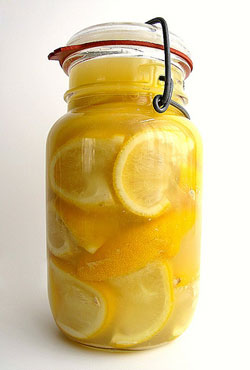 My one favorite thing about the winter season is citrus fruit. When I have a good lemon or orange in hand, I almost forget about the mountains of snow and the blistery weather. I always seek out unusual citrus fruits, from Meyer lemons to blood oranges. But the one citrus fruit I use most is the standard lemon. The ones available in the supermarket are typically the Eureka variety. I use those juicy yellow orbs in practically every recipe. Salad dressings, baked goods, and stews all benefit from a little lemon, be it the juice or zest. The aroma and flavor of lemons are what make them so special and revered in many cuisines.
My one favorite thing about the winter season is citrus fruit. When I have a good lemon or orange in hand, I almost forget about the mountains of snow and the blistery weather. I always seek out unusual citrus fruits, from Meyer lemons to blood oranges. But the one citrus fruit I use most is the standard lemon. The ones available in the supermarket are typically the Eureka variety. I use those juicy yellow orbs in practically every recipe. Salad dressings, baked goods, and stews all benefit from a little lemon, be it the juice or zest. The aroma and flavor of lemons are what make them so special and revered in many cuisines.
